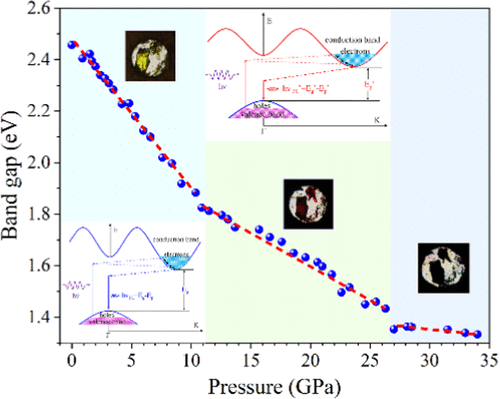当前位置:
X-MOL 学术
›
J. Phys. Chem. C
›
论文详情
Our official English website, www.x-mol.net, welcomes your
feedback! (Note: you will need to create a separate account there.)
Electronic Structure of LLM-105 Crystal under High Pressure and Low Temperature
The Journal of Physical Chemistry C ( IF 3.3 ) Pub Date : 2020-01-21 , DOI: 10.1021/acs.jpcc.0c00055 Zilong Xu 1 , Qiao Chen 1 , Xiangdong Li 1 , Junke Wang 1 , Xiangqi Wang 1 , Chan Gao 2 , Rucheng Dai 2 , Zhongping Wang 2 , Shiliang Huang 3 , Yu Liu 3 , Hongzhen Li 3 , Zengming Zhang 2, 4
The Journal of Physical Chemistry C ( IF 3.3 ) Pub Date : 2020-01-21 , DOI: 10.1021/acs.jpcc.0c00055 Zilong Xu 1 , Qiao Chen 1 , Xiangdong Li 1 , Junke Wang 1 , Xiangqi Wang 1 , Chan Gao 2 , Rucheng Dai 2 , Zhongping Wang 2 , Shiliang Huang 3 , Yu Liu 3 , Hongzhen Li 3 , Zengming Zhang 2, 4
Affiliation

|
The electronic structural evolution of LLM-105 crystal under high pressure and low temperature is investigated by photoluminescence, absorption, Raman spectra, and density functional theory (DFT) calculations. The result shows that the LLM-105 crystal possesses a large tunable indirect band gap from 2.45 eV at the ambient condition to 1.33 eV at 34.0 GPa. With increasing pressure at room temperature, the luminescence of LLM-105 crystal first increases in intensity owing to the raised absorption at excited wavelength and the enhanced hydrogenbond network; then, over 9.0 GPa, the increase of nonradiative transition probability causes the decrease of emission intensity due to the increase of phonon energy. In the cooling process under high pressure, the emission is enhanced due to the lower phonon energy and the pressure value at maximum emission can be adjusted up to 10.2 GPa at 200 K from 9 GPa at room temperature. The absorption evolution reveals that the band gap of LLM-105 crystal decreases as the pressure increases and an electronic structure phase transition occurred at about 10 GPa. The DFT calculation indicated that it is attributed to the electronic transfer abrupt change from the exposed oxygen atom to the amino groups at about 10 GPa, which also reduces the band gap red shift rate. A pressure-induced structure phase transition occurs at 26.5 GPa indicated by a sudden decrease of band gap. This material is expected to be metalized under further compression up to about 250 GPa.
中文翻译:

高压和低温下LLM-105晶体的电子结构
通过光致发光,吸收,拉曼光谱和密度泛函理论(DFT)计算研究了LLM-105晶体在高压和低温下的电子结构演化。结果表明,LLM-105晶体具有从环境条件下的2.45 eV到34.0 GPa时的1.33 eV的较大的可调间接带隙。随着室温下压力的增加,由于激发波长处吸收的增加和氢键网络的增强,LLM-105晶体的发光强度首先增加。然后,超过9.0 GPa,非辐射跃迁几率的增加由于声子能量的增加而导致发射强度的降低。在高压下的冷却过程中 由于较低的声子能量,发射得到增强,并且在200 K时,最大发射的压力值可以从室温下的9 GPa调节到10.2 GPa。吸收演化表明,LLM-105晶体的带隙随着压力的增加而减小,并且在约10 GPa时发生电子结构的相变。DFT计算表明,这归因于大约10 GPa时从暴露的氧原子到氨基的电子转移突然改变,这也降低了带隙红移率。压力诱导的结构相变发生在26.5 GPa,由带隙的突然减小指示。预计该材料将在高达250 GPa的压力下进一步金属化。吸收演化表明,LLM-105晶体的带隙随着压力的增加而减小,并且在约10 GPa时发生电子结构的相变。DFT计算表明,这归因于大约10 GPa时从暴露的氧原子到氨基的电子转移突然改变,这也降低了带隙红移率。压力引起的结构相变发生在26.5 GPa,由带隙的突然减小指示。预计该材料将在高达250 GPa的压力下进一步金属化。吸收演化表明,LLM-105晶体的带隙随着压力的增加而减小,并且在约10 GPa时发生电子结构的相变。DFT计算表明,这归因于大约10 GPa时从暴露的氧原子到氨基的电子转移突然改变,这也降低了带隙红移率。压力引起的结构相变发生在26.5 GPa,由带隙的突然减小指示。预计该材料将在高达250 GPa的压力下进一步金属化。DFT计算表明,这归因于大约10 GPa时从暴露的氧原子到氨基的电子转移突然改变,这也降低了带隙红移率。压力诱导的结构相变发生在26.5 GPa,由带隙的突然减小指示。预计该材料将在高达250 GPa的压力下进一步金属化。DFT计算表明,这归因于大约10 GPa时从暴露的氧原子到氨基的电子转移突然改变,这也降低了带隙红移率。压力诱导的结构相变发生在26.5 GPa,由带隙的突然减小指示。预计该材料将在高达250 GPa的压力下进一步金属化。
更新日期:2020-01-22
中文翻译:

高压和低温下LLM-105晶体的电子结构
通过光致发光,吸收,拉曼光谱和密度泛函理论(DFT)计算研究了LLM-105晶体在高压和低温下的电子结构演化。结果表明,LLM-105晶体具有从环境条件下的2.45 eV到34.0 GPa时的1.33 eV的较大的可调间接带隙。随着室温下压力的增加,由于激发波长处吸收的增加和氢键网络的增强,LLM-105晶体的发光强度首先增加。然后,超过9.0 GPa,非辐射跃迁几率的增加由于声子能量的增加而导致发射强度的降低。在高压下的冷却过程中 由于较低的声子能量,发射得到增强,并且在200 K时,最大发射的压力值可以从室温下的9 GPa调节到10.2 GPa。吸收演化表明,LLM-105晶体的带隙随着压力的增加而减小,并且在约10 GPa时发生电子结构的相变。DFT计算表明,这归因于大约10 GPa时从暴露的氧原子到氨基的电子转移突然改变,这也降低了带隙红移率。压力诱导的结构相变发生在26.5 GPa,由带隙的突然减小指示。预计该材料将在高达250 GPa的压力下进一步金属化。吸收演化表明,LLM-105晶体的带隙随着压力的增加而减小,并且在约10 GPa时发生电子结构的相变。DFT计算表明,这归因于大约10 GPa时从暴露的氧原子到氨基的电子转移突然改变,这也降低了带隙红移率。压力引起的结构相变发生在26.5 GPa,由带隙的突然减小指示。预计该材料将在高达250 GPa的压力下进一步金属化。吸收演化表明,LLM-105晶体的带隙随着压力的增加而减小,并且在约10 GPa时发生电子结构的相变。DFT计算表明,这归因于大约10 GPa时从暴露的氧原子到氨基的电子转移突然改变,这也降低了带隙红移率。压力引起的结构相变发生在26.5 GPa,由带隙的突然减小指示。预计该材料将在高达250 GPa的压力下进一步金属化。DFT计算表明,这归因于大约10 GPa时从暴露的氧原子到氨基的电子转移突然改变,这也降低了带隙红移率。压力诱导的结构相变发生在26.5 GPa,由带隙的突然减小指示。预计该材料将在高达250 GPa的压力下进一步金属化。DFT计算表明,这归因于大约10 GPa时从暴露的氧原子到氨基的电子转移突然改变,这也降低了带隙红移率。压力诱导的结构相变发生在26.5 GPa,由带隙的突然减小指示。预计该材料将在高达250 GPa的压力下进一步金属化。











































 京公网安备 11010802027423号
京公网安备 11010802027423号